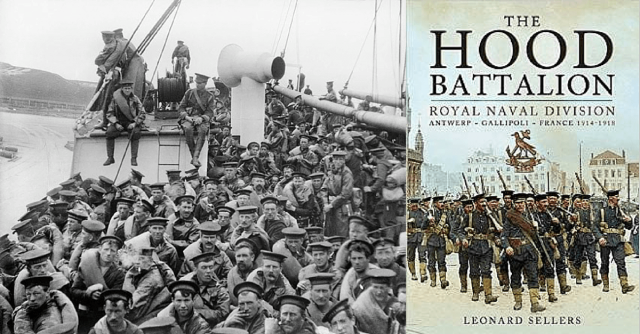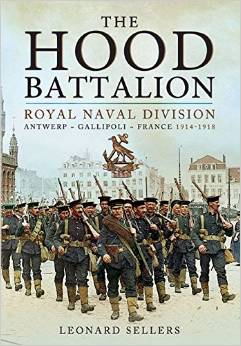This is, as the title says, a history of the Hood Battalion of the Royal Naval Division and the book is in its third run. The idea of sailors and marines fighting on land was not a new concept in 1914, a naval brigade served during the Boer War and before. The Royal Naval Division was born out of the pre war plan to have the Advanced Base Force, or the Marine Brigade. At the outbreak of the Great War this plan was implemented and expanded. The surplus numbers of reserve sailors, too many for ships, provided enough men to form Winston Churchill’s “Little Army” or the RND as it became known. Despite being formed first and being made up of a number of professional sea-going soldiers, in true naval style,the Marine Brigade became the 3rdor last Brigade of the new division. The 1st and 2nd Brigades, made up of reservist sailors and Kitchener volunteers, most of which were not professional soldiers,were placed ahead of the marines. The brigades were made up of battalions, the first eight were named after naval heroes, hence the Hood battalion and the Marine battalions were named after naval bases.
It is an emotional book instigated by family tree research. It contains a number of poems and in the Gallipoli section leans heavily on Rupert Brooke’s last days. At first the poetry irritated me, not because I dislike poetry but because I questioned its place in the work.However, after a while I realised that in most cases the poetry has a place in the book from an emotional standpoint. There are moments of humour as well. I thoroughly enjoyed the little piece that describes Winston Churchill offering his resignation as First Lord of the Admiralty and declaring that he was going to take command of the troops defending Antwerp, thereby promoting himself to de facto Lieutenant-General. Imagine the horror at Horse Guards and Whitehall! Needless to say that this little ‘wheeze’ of Winston’s did not come off. It was certainly an indicator as to Winston’s cast of mind during the Great War and well done Leonard Sellers for including it.
The book is divided into three sections. “The Early Days” with four chapters covering the formation of the battalions and therefore the division, the disastrous Antwerp episode, training at Crystal Palace and then at Blandford. Ten chapters examine “The Hood At Gallipoli” and twelve chapters cover “The Hood On The Western Front”, although the first, short chapter of this section, “The Future in the Balance”, deals with the division’s five month spell on Lemnos and Tenedos after the evacuation of Gallipoli. This is something that I found interesting largely because the post Gallipoli evacuation episode is not often written about. I have to admit that I chuckled at the unconscious humour when Sellers says of the Hood Battalion at Mudros on Lemnos, “Apart from dysentery and paratyphoid fever there was little to complain about.”
Sellers has formed the opinion that Gallipoli was “a close run thing”. This comes through in the second section of the book and is no doubt the attitude of the soldiers whose memoirs and diaries he used. It is certainly true of Joseph Murray whose work Gallipoli As I Saw it (William Kimber and Co Ltd, 1965) Sellers quotes extensively. There are two schools of thought about Gallipoli, one is “a close run thing” and, as I’m sure you know, the other is “it was a non-starter from the outset.” Sellers also says that the best Turkish soldiers were German trained and that German ingenuity and German officers made the real difference. I personally don’t agree with either of these notions, however, in my opinion the Gallipoli section is the best part of the book.
The wrangling between the Admiralty and the War Office as to who controlled this orphan, 63rd (Royal Naval) Division went on for some time; it was almost disbanded a few times in its war career but always managed to survive and its battalions fought on. They apparently fought well and the division was considered to be a ‘good’ one. The third section about the Western Front is, unsurprisingly, pretty much the standard fare of trench warfare. Although by the end of 1917 this section runs out of steam. Nineteen Eighteen is covered in one very abrupt, short chapter as is the disbanding of the division. I think this is a shame because Sellers has evidently done a large amount of work on the rest of the book and rushing the end sells the battalion history short.
Nonetheless it is still a decent addition to the collection of battalion and divisional histories and useful for those who collect unit histories or use them for research. The book contains the Antwerp Muster Role, the end notes deal with the references and sources, there is no bibliography and a surprisingly short index. This is an old book repackaged as part of Pen & Sword’s campaign to re-print their Great War back catalogue and it is good to see that it has been re-issued again.Although I wonder how long this print run will last. It is worth having, that is if you didn’t buy the book the last couple of times it came out!
Reviewed by Dr Wayne Osborne for War History Online.
THE HOOD BATTALION, ROYAL NAVAL DIVISION
Antwerp, Gallipoli, France 1914 – 1918
By Leonard Sellers
First published by Leo Cooper, 1995. Reprinted by Pen & Sword Ltd, 2003 and 2014.
Paperback, 334 pages
ISBN 978 1 78346 168 4


